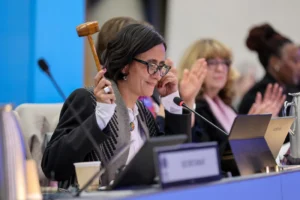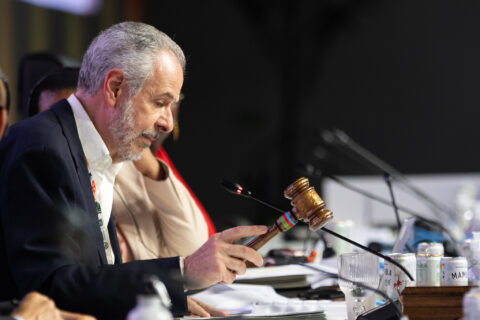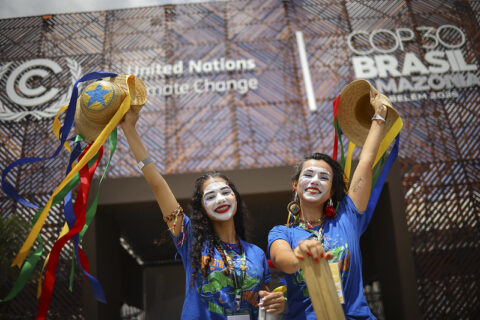The global energy transition is now “unstoppable” due to “smart economics”, UN general-secretary António Guterres has said in an online speech titled: “A moment of opportunity.”
His comments coincide with two reports released today, one from International Renewable Energy Agency (IRENA) and the other from the UN that utilises the former’s research.
Between them, the reports provide details of how the “plummeting” cost of renewables has helped the sector expand at pace, meaning that renewables now almost match fossil fuels in terms of global installed power capacity.
In 2024, 91% of renewable power projects that were commissioned were more cost effective than any new fossil-fuel alternatives, according to IRENA.
The 582 gigawatts (GW) of renewable energy capacity added to the global energy system in 2024 helped avoid fossil-fuel use valued at about $57bn, with further cost savings expected as the sector continues to grow.
In his speech, Guterres said:
“Throughout history, energy has shaped the destiny of humankind – from mastering fire, to harnessing steam, to splitting the atom. Now, we are on the cusp of a new era. Fossil fuels are running out of road. The sun is rising on a clean-energy age.”
Below, Carbon Brief details five of the key points from the reports and Guterres’ speech.
- Renewables are increasing as costs fall
- Investment in clean energy tips $2bn
- ‘Stability…in a volatile global energy landscape’
- China dominates deployment…others should now follow
- ‘Faster and fairer’ for 1.5C
Renewables are increasing as costs fall
The cost of renewable energy technologies has fallen over the past decade, with 96% of new solar and wind now costing less than new coal and gas plants, according to IRENA.
In 2024, the global average cost of electricity generated by solar photovoltaics (PV) and onshore wind was 41% and 53% cheaper, respectively, than the least-cost new fossil fuel-fired power plant.
The global average cost of solar PV has fallen to $0.43 per kilowatt-hour (kWh) and onshore wind to $0.34/kWh.

There were some small increases in costs between 2023 and 2024 for some technologies, IRENA notes. Solar PV’s levelised cost of electricity (LCOE) increased by 0.6%, onshore wind by 3%, offshore wind by 4% and bioenergy by 13%.
According to BloombergNEF, increases were broadly due to inflation and supply chain pressures. These led to the first jump in the costs of offshore wind in the UK’s renewable energy auctions, for example.
However, IRENA explains that long-term cost reductions are expected to continue, as further technological lessons are “learnt” and supply chains mature.
Alongside this drop in cost, renewable energy capacity has increased significantly over the past decade, growing by around 2,600GW, or 140%, between 2015 and 2024, according to the UN report.
Over the same period, fossil fuels increased by around 640GW, or 16%.
In 2024 alone, renewables made up 92.5% of all new electricity capacity additions, as well as 74% of electricity generation growth.
This means that the share of global installed capacity is now nearly a 1:1 ratio between fossil fuels and renewables, the UN report notes.
Between 2015 and 2024, renewables increased by 81% in terms of global annual electricity generation compared to a 13% increase for fossil fuels.
The global rollout of solar and wind is already having a significant impact on emissions, saving almost the equivalent of the EU’s annual emissions.
Despite the increase in renewable energy capacity to date, lagging investment in expanding and modernising electricity grids is “becoming a bottleneck for the energy transition”, cautions the UN report. There are at least 3,000GW of renewable power projects waiting for a grid connection.
Investment in clean energy tips $2bn
In 2024, global annual clean-energy investments exceeded $2tn for the first time, according to the UN report.
This is $800bn more than fossil-fuel investment, as shown in the chart below, up almost 70% in 10 years. It follows investment in clean energy surpassing fossil-fuel investment in 2016.

Subsequently, the number of jobs in the clean-energy sector has also continued to grow, reaching 34.8m in 2023, of which 16.2n were in the renewables sector.
According to the UN report, in 2023, the clean-energy sector added $320bn to the global economy. This accounted for 10% of GDP growth globally.
Clean energy accounted for an even higher percentage in certain regions, For example, nearly a third of the EU’s GDP came from the sector. It made up 5% in India, 6% in the US and 20% in China.
In his speech, Guterres noted that, despite clean energy increasingly driving economies, there is still “clean market distortion” with fossil fuels benefiting nine-to-one from consumption subsidies globally. He continued:
“Add to that the unaccounted costs of climate damages on people and planet – and the distortion is even greater. Countries that cling to fossil fuels are not protecting their economies – they are sabotaging them. Driving up costs. Undermining competitiveness. Locking-in stranded assets. And missing the greatest economic opportunity of the 21st century.”
The UN report notes that, in 2024, the economic losses from weather-related extreme events were estimated to be $320bn, of which 56% were uninsured.
Under IRENA’s 1.5C scenario for the energy transition, global annual GDP would increase by 1.5% between 2023 and 2050.
‘Stability…in a volatile global energy landscape’
In 2024, renewable energy helped “avoid” $467bn in fossil-fuel costs globally, according to IRENA.
This reinforces renewables’ role as “not only as the lowest-cost source of new power, but also as a key driver of energy security, economic stability and resilience in a volatile global energy landscape”.
Between 2000 and 2023, Asia saw the biggest savings from clean-energy investment, with £212bn avoided, as shown on the chart below.
This was predominantly due to China, where renewable energy is surging, helping to put the country’s emissions “into reverse” for the first time earlier this year, according to Carbon Brief analysis. (The UN report cites two articles published by Carbon Brief this year.)

In a statement released alongside the report, IRENA director-general Francesco La Camera said:
“The cost-competitiveness of renewables is today’s reality. Looking at all renewables currently in operation, the avoided fossil-fuel costs in 2024 reached up to $467bn. New renewable power outcompetes fossil fuels on cost, offering a clear path to affordable, secure and sustainable energy. This achievement is the result of years of innovation, policy direction and growing markets.”
Additionally, the continued expansion of renewable energy technologies can, says the UN report, help to protect people from the impact of geopolitical instability on international energy markets.
Around 74% of the global population lives in a country that is a net importer of fossil fuels, the report notes. As such, when oil and gas prices surge, they are left particularly vulnerable.
For example, following Russia’s invasion of Ukraine in 2022, gas prices reached record highs and oil prices hit their highest level since 2008, the UN report adds.
Consequently, the average energy bill globally was 20% higher than the average over the previous five years. This was more acute in countries that are particularly reliant on gas imports, such as South Korea, which spent $17bn more on gas in 2022 compared to 2021.
China dominates deployment…others should now follow
While renewable energy deployment has been increasing around the world, the distribution remains uneven, notes the UN report.
As shown in the chart, of the 4,448GW of total renewable capacity installed globally as of the end of 2024, 41% was in China, 39% in OECD countries and almost half of the remaining 20% in Brazil and India.

Africa made up just 1.5% of the capacity installed by the end of last year, despite accounting for 85% of the global population without electricity access and having a renewable energy resource potential 10 times larger than the continent’s projected electricity demand in 2040.
Since 2016, outside of China, less than one in every five dollars invested in clean energy has gone to emerging markets and developing economies (EMDEs), explains the UN report.
Investment is hampered in part by higher costs in EMDEs – for example, the cost of capital for a large-scale solar PV project in one of these economies is well over twice as high as in advanced economies, adds the UN report.
To keep the Paris Agreement’s 1.5C goal within reach, annual clean-energy spending in EMDEs beyond China will need to increase by around five to seven times from 2022 levels, notes the UN report. This would see investment increase to $1.4-1.9tn a year in 2030 and to more than $2tn a year by 2035.
‘Faster and fairer’ for 1.5C
The UN and IRENA reports, along with Gueterres’ speech, highlight that, while progress in transitioning the energy sector away from fossil fuels is underway, “the transition is not yet fast enough or fair enough”.
Since the Paris Agreement came into force almost a decade ago, the collective ratcheting up of global climate ambition and action has meant that “projected global warming has been progressively declining”, the report notes.
It points to the UNEP emissions gap report, which found that warming this century under current policies have fallen from just below 4C to 3.1C. If parties’ conditional climate pledges – known as nationally determined contributions (NDCs) – are fully implemented, warming could fall from 3-3.5C to 2.6C.
This would be lower still, falling to 1.9C, if all net-zero pledges are fully achieved, the UN report notes.
As such, parties need to do more to take advantage of the opportunity presented by the “dawn of a new energy era”, Guterres said, as the “fossil-fuel age is flailing and failing”.
He set out six “opportunity areas”, which include NDCs, meeting surging energy demand with sustainable sources and using trade and investment to “supercharge” the energy transition.
The UN report highlights that at COP28 in Dubai, parties agreed to global targets to triple renewable energy capacity by 2030, double the annual rate of energy efficiency improvement and transition away from fossil fuels in line with global net-zero emissions by 2050.
In his speech, Guterres said “we must drastically speed up the reduction of emissions – and the reach of the clean-energy transition” to reach these goals as the “1.5C limit is in unprecedented peril”.
The impact of current plans and policies, in comparison to those needed to align with 1.5C, is shown in the chart below.

In his statement, La Camera welcomed the surge in renewables to date, but added:
“Progress is not guaranteed. Rising geopolitical tensions, trade tariffs and material supply constraints threaten to slow the momentum and drive up costs. To safeguard the gains of the energy transition, we must reinforce international cooperation, secure open and resilient supply chains, and create stable policy and investment frameworks – especially in the global south. The transition to renewables is irreversible, but its pace and fairness depend on the choices we make today.”
The post UN: Five reasons why switching to renewables is ‘smart economics’ appeared first on Carbon Brief.
UN: Five reasons why switching to renewables is ‘smart economics’
Climate Change
Brazil’s Lula requests national roadmap for fossil fuel transition
Brazil’s President Luiz Inácio Lula da Silva has asked his government to draft by February guidelines for a national roadmap to transition away from fossil fuels, an idea he championed during COP30.
In a directive issued on Monday, the Brazilian leader requested the ministries of finance, energy and environment, together with the chief of staff’s office, to come up with a proposal for a roadmap to a “just and planned energy transition” that would lead to the “gradual reduction of the country’s dependence on fossil fuels”.
The order also calls for the creation of financial mechanisms to support a roadmap, including an “Energy Transition Fund” that would be financed with government revenues from oil and gas exploration.
The guidelines, due in 60 days, will be delivered “as a priority” to Brazil’s National Energy Policy Council, which will use them to craft an official fossil fuel transition roadmap.
At the COP30 climate summit in Brazil, President Lula and Environment Minister Marina Silva called on countries to agree a process leading to an international roadmap for the transition away from fossil fuels, after Silva argued earlier in June that “the worst possible thing would be for us to not plan for this transition”.
Yet, to the disappointment of more than 80 countries, the proposal for a global roadmap did not make it into the final Belém agreement as other nations that are heavily reliant on fossil fuel production resisted the idea. Draft compromise language that would have offered countries support to produce national roadmaps was axed.
Brazil seeks to set an example
Instead, Brazil’s COP30 president said he would work with governments and industry on a voluntary initiative to produce such a roadmap by next year’s UN climate summit, while a group of some 25 countries backed a conference to discuss a just transition away from coal, oil and gas that will be hosted by Colombia and the Netherlands in April 2026.
Experts at Observatório do Clima, a network of 130 Brazilian climate NGOs, welcomed Lula’s subsequent order for a national roadmap and said in a statement it sends signals abroad that Brazil is “doing its homework”.
“President Lula seems to be taking the roadmap proposal seriously,” said Cláudio Angelo, international policy coordinator at Observatório do Clima. “If Brazil – a developing country and the world’s eighth-largest oil producer – demonstrates that it is willing to practice what it preaches, it becomes harder for other countries to allege difficulties.”
The Amazon rainforest emerges as the new global oil frontier
Brazil is one of a number of countries planning a major expansion of oil and gas extraction in the coming decade, according to the Production Gap report put together by think-tanks and NGOs. Much of the exploration is set to take place offshore near the Amazon basin, which is poised to become a new frontier for fossil fuel development.
Significant funding needed
Natalie Unterstell, president of the Brazilian climate nonprofit Talanoa Institute and a member of Lula’s Council for Sustainable Social Economic Development, welcomed the national roadmap proposal in a post on LinkedIn, but emphasised it must tackle Brazil’s goal of becoming the world’s fourth largest oil producer by 2030.
Another key question is whether the Energy Transition Fund it envisages will be large enough to catalyse a real shift over to clean energy, she added. “Small and fragmented tools won’t move the dial,” she wrote.
Some Brazilian states have tested a model similar to the proposal for a national Energy Transition Fund. In the oil-producing state of Espirito Santo, for example, a percentage of the state government’s oil revenues go to a sovereign fund that invests in renewable energy, energy efficiency projects and substitution of fossil fuels with less polluting alternatives.
Colombia seeks to speed up a “just” fossil fuel phase-out with first global conference
Andreas Sieber, associate director for policy at campaign group 350.org, said a meaningful roadmap for Brazil would need to secure “adequate, fair and transparent financing to make the transition real on the ground”.
He also called for “a truly participatory process – involving scientists, civil society, workers whose livelihoods are at stake, and frontline and traditional communities whose rights must be upheld – while ensuring that those with vested fossil fuel interests do not shape the outcome”.
The post Brazil’s Lula requests national roadmap for fossil fuel transition appeared first on Climate Home News.
Brazil’s Lula requests national roadmap for fossil fuel transition
Climate Change
Environmental Groups Demand a Nationwide Freeze on Data Center Construction
In a letter to Congress, the groups said data center development raises concerns about rising energy costs, water use and climate impacts. Many communities are fighting back.
More than 200 environmental organizations signed a letter to Congress supporting a national moratorium on the approval and construction of new data centers. The letter, sent Monday, highlights these centers’ impacts on water resources, electricity rates and greenhouse gas emissions.
Environmental Groups Demand a Nationwide Freeze on Data Center Construction
Climate Change
The Household Choice: Climate Change and the Weight of Everyday Decisions
Climate change is often discussed in global terms, such as the melting of ice caps, rising oceans, and the spread of wildfires. However, the truth is that it begins at home. Every single-family household, whether in the bustle of Toronto, the suburbs of Vancouver, a farming community on the Prairies, or a small northern town, is an active participant in shaping the climate future. The actions we take or fail to take are not isolated. They accumulate, reverberate, and shape the quality of life our children, grandchildren, and great-grandchildren will inherit.
The Myth of Insignificance
Many households believe their contribution is too small to matter. “What difference does it make if I leave the lights on, drive everywhere, or throw food scraps in the garbage? I’m just one family.” But this myth of insignificance is one of the greatest dangers of our time. Each discarded plastic bottle, each unnecessary car trip, each bag of wasted food does not disappear. It piles up, becoming part of the global crisis of climate change. What feels like a private choice is, in reality, a public consequence.
Inaction as a Legacy
Imagine a Canadian family that chooses not to recycle, not to conserve, not to shift their habits. For a year, the consequences may feel invisible. But roll the clock forward. By 2050, their grandchildren in Toronto will wake up to summers filled with weeks-long heat advisories. Schoolyards and parks sit empty in July because it is too dangerous for children to play outdoors. Ontario’s hydro grid is stretched thin due to millions of air conditioners running simultaneously, leading to rolling blackouts. Food prices have doubled as droughts in the Prairies devastate crops, and supply chains falter. Sound familiar? Its already happening across Canada!
Meanwhile, their cousins in Prince Edward Island are coping with rising seas. Entire communities along the coast are gone, washed away by storm surges that happen with increasing frequency. Families that lived by the water for generations have been forced inland, their ancestral homes now threatened by sea rise. This is not exaggeration, climate science paints a stark and very real picture of future coastal realities.
By 2075, their great-grandchildren in northern communities will live with constant water restrictions, as the thawing of permafrost has altered rivers and lakes. Traditional hunting grounds are unsafe because the ice forms too late and melts too soon. Invasive pests and fire scar forests that once provided medicine and food. The Earth around them bears the weight of countless small inactions compounded across time. And when they look back, they see a generation that knew better but refused to change.
Action as a Legacy
Now imagine another Canadian family. They compost, recycle, conserve, and teach their children that every small act of stewardship makes a difference. For a year, the impact may seem modest. But roll the clock forward.
By 2050, their grandchildren in Winnipeg will be growing vegetables in backyard and community gardens, nourished by decades of composting. Energy bills are lower because their homes are equipped with rooftop solar panels and properly insulated to conserve heat in winter and cool in summer. Children still play outside freely because air quality warnings are rare.
Out east, their relatives in Halifax have adapted coastal homes to utilize renewable energy micro-grids and employ storm-resilient design. They continue to live by the ocean, harvesting from healthier waters thanks to decades of careful stewardship and waste reduction. By 2075, their great-grandchildren in northern Ontario communities thrive in local economies powered by clean energy.
Rivers run clearer because they are not treated as dumping grounds. Indigenous and non-Indigenous households work together in climate-adaptive food systems, including greenhouses, hydroponics, and land-based harvesting, to ensure food security without overburdening ecosystems. This family’s small actions, multiplied over decades, became part of a collective movement toward renewal.
The Full Cycle of Consequence
Every household action has a cycle. Throwing out food waste creates methane gas, which accelerates global warming, intensifying storms that flood homes, including those in Montreal, Calgary, and Fredericton. Driving when public transit is available contributes to emissions, which in turn lead to hotter summers in Ottawa, resulting in higher cooling costs, increased strain on the grid, and potentially blackouts during heatwaves. Buying fast fashion creates textile waste that ends up in Canadian landfills, similar to those outside Vancouver or Edmonton, polluting soils and waterways long after today’s wearers are gone.
The cycle is relentless, and it all begins with decisions made in the privacy of the household. What we must recognize is that there is no neutral choice. Every action either adds to the problem or contributes to the solution.
Looking Generations Ahead
The question is not whether a single-family household can “solve” climate change. It cannot. The question is: will this household’s actions add to the burden or lighten it? Will future children, grandchildren, and great-grandchildren wake each morning in a Canada that is habitable and thriving, or one that is hostile and diminished?
To answer this question, every family must reflect on what kind of ancestors they want to be remembered as. Because, in truth, the climate crisis is not just about us; it is about them.
Blog by Rye Karonhiowanen Barberstock
Image Credit :Olivie Strauss, Unsplash
The post The Household Choice: Climate Change and the Weight of Everyday Decisions appeared first on Indigenous Climate Hub.
The Household Choice: Climate Change and the Weight of Everyday Decisions
-
Climate Change4 months ago
Guest post: Why China is still building new coal – and when it might stop
-
Greenhouse Gases4 months ago
Guest post: Why China is still building new coal – and when it might stop
-
Climate Change2 years ago
Spanish-language misinformation on renewable energy spreads online, report shows
-

 Greenhouse Gases2 years ago
Greenhouse Gases2 years ago嘉宾来稿:满足中国增长的用电需求 光伏加储能“比新建煤电更实惠”
-
Climate Change Videos2 years ago
The toxic gas flares fuelling Nigeria’s climate change – BBC News
-

 Climate Change2 years ago
Climate Change2 years ago嘉宾来稿:满足中国增长的用电需求 光伏加储能“比新建煤电更实惠”
-

 Carbon Footprint2 years ago
Carbon Footprint2 years agoUS SEC’s Climate Disclosure Rules Spur Renewed Interest in Carbon Credits
-
Climate Change2 years ago
Why airlines are perfect targets for anti-greenwashing legal action











